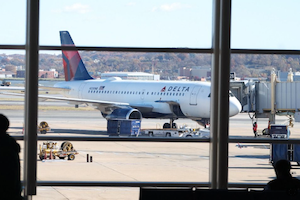U.S. Shutdown Day 38: Airlines Reeling, Flights May Drop 20%

The U.S. government shutdown has entered its 38th day, with air traffic controllers and security personnel missing work in large numbers after weeks without pay, causing a significant disruption to domestic air travel. The Federal Aviation Administration (FAA) this week ordered 40 high-traffic airports to reduce flight operations by 4% starting Friday (local time) and plans to raise the reduction to 10% by November 14. U.S. Transportation Secretary Sean Duffy warned that if the shutdown continues, the “worst-case scenario” could force flight reductions of up to 20% during certain periods.
Real-time data show that since the shutdown began on October 1, absenteeism among air traffic controllers and Transportation Security Administration (TSA) officers has led to a sharp increase in flight delays and cancellations. Aviation data indicate that in recent days, over a thousand flights per day have been delayed or canceled, affecting several million passengers in total. Both airlines and travelers are expressing growing concern about the approaching Thanksgiving travel rush.
The FAA and the Department of Transportation (DOT) emphasized that these measures are driven by safety considerations. The FAA has implemented air traffic flow restrictions at several major airports, requiring airlines to cancel or reschedule flights to “reduce airspace pressure and ensure safe operating intervals for crews and controllers.” Secretary Duffy told the media that if staffing shortages worsen, flight reductions could increase gradually from the current 4% to 10%, 15%, or even “as high as 20%.” He urged Congress to act swiftly to reopen the government and prevent broader flight disruptions.
Multiple media and industry reports added that the impact extends to both domestic and some international flights. The hardest-hit hubs include New York, Atlanta, Chicago, Los Angeles, and San Francisco — airports where any staffing shortage quickly triggers cascading delays. According to Reuters, absentee rates among controllers vary widely by airport, ranging from 20% to 40% daily, and in some hubs have reached as high as 80%, significantly reducing available air traffic capacity.
Airlines now face a double burden: complying with FAA-mandated flight cuts while struggling to adjust fleets and staffing amid waves of passenger rescheduling and cancellations. Major U.S. carriers have already begun reducing flight frequencies and adjusting timetables, warning passengers of heightened risks of delays and cancellations. Some reports suggest that if the shutdown continues into the holiday peak, overall flight capacity could fall by up to 20%, affecting ticket supply, pricing, and the broader transportation network.
This shutdown marks one of the longest in U.S. history, forcing federal employees to work without pay or take unpaid leave. Critical services in defense, border security, homeland security, and transportation have all been affected. The aviation sector, which relies heavily on federally managed personnel like air traffic controllers and TSA agents, is among the first industries to feel the direct impact. Whether Congress and the White House can resolve their political impasse soon will directly determine how quickly flight operations can recover.
As flight disruptions continue to mount, travel experts and media outlets are advising passengers to: reconfirm flight status before departure, stay alert to airline notifications, avoid tight connections during peak hours, and consider adjusting travel dates. Those planning international or holiday travel are urged to contact airlines or travel agencies early to minimize risk.
With the shutdown now in its 38th day, pressure on the aviation sector shows no sign of easing. If the political stalemate drags on and staffing levels at major airports fail to recover, Secretary Duffy’s warning of “up to 20% flight reductions” could shift from a worst-case projection to a grim reality — one that may reshape nationwide travel and ripple across the U.S. economy.
- 51 reads
Human Rights
Fostering a More Humane World: The 28th Eurasian Economic Summi

Conscience, Hope, and Action: Keys to Global Peace and Sustainability

Ringing FOWPAL’s Peace Bell for the World:Nobel Peace Prize Laureates’ Visions and Actions

Protecting the World’s Cultural Diversity for a Sustainable Future

Puppet Show I International Friendship Day 2020

